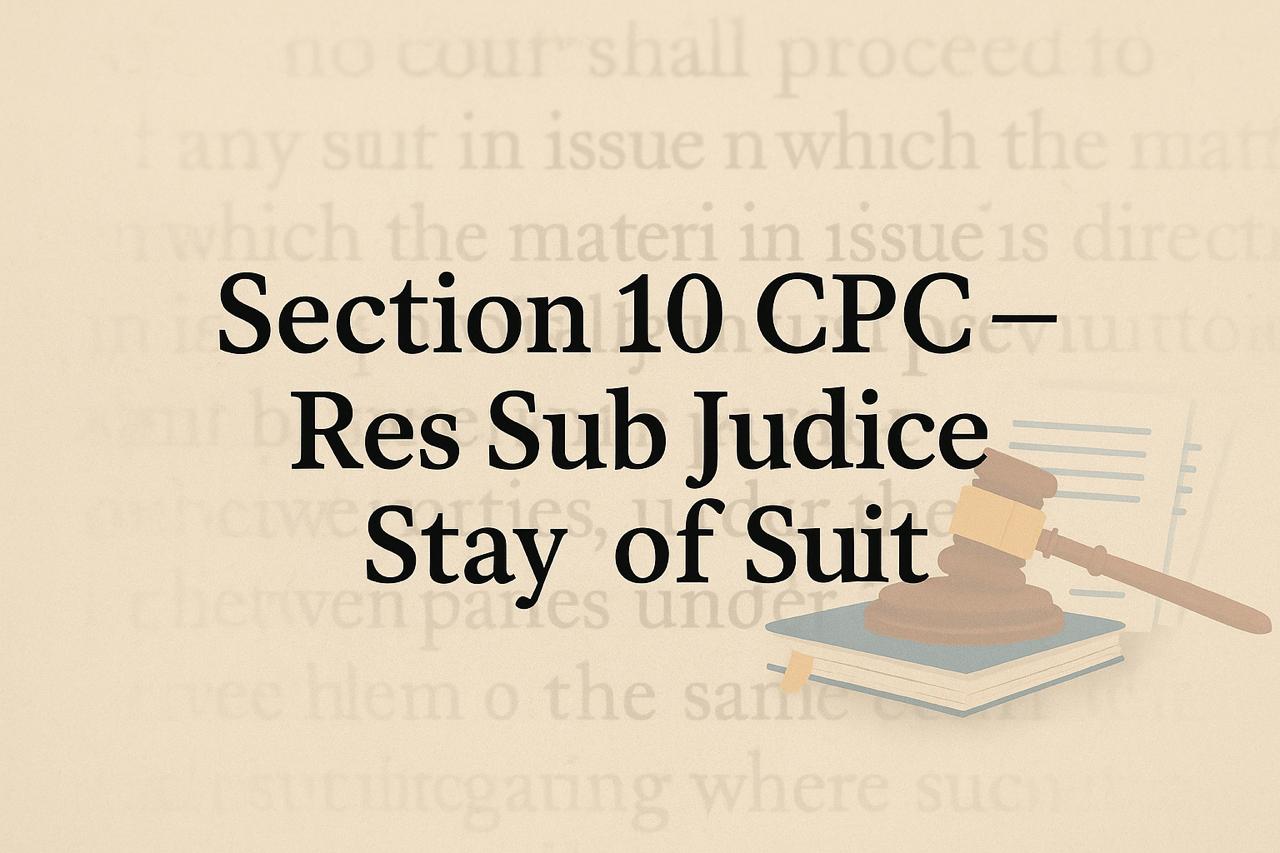 Res Sub Judice: Stay of Suit under Section 10 CPC
Res Sub Judice: Stay of Suit under Section 10 CPC
Introduction
Section 10 of the Code of Civil Procedure (CPC) embodies the doctrine of Res Sub Judice, which literally means “a matter under judicial consideration”. The provision is aimed at preventing simultaneous trials of two suits in different courts when the matter in issue is the same, thereby avoiding conflicting decisions and multiplicity of proceedings.
Statutory Provision
Section 10 reads as follows:
“No court shall proceed with the trial of any suit in which the matter in issue is also directly and substantially in issue in a previously instituted suit between the same parties, or between parties under whom they or any of them claim litigating under the same title where such suit is pending in the same or any other court in India having jurisdiction to grant the relief claimed, or in any court beyond the limits of India established or constituted by the Central Government and having like jurisdiction, or before the Supreme Court.”
Explanation: The pendency of a suit in a foreign court does not preclude Indian courts from trying a suit founded on the same cause of action.
Object of Section 10
The primary purpose of Section 10 is:
• To avoid multiplicity of proceedings.
• To prevent two courts of concurrent jurisdiction from trying the same matter at the same time.
• To avoid the risk of conflicting decisions.
Conditions for Applicability
For Section 10 to apply, the following conditions must be satisfied:
1. There must be two suits – one previously instituted and another subsequently instituted.
2. The matter in issue in the subsequent suit must be directly and substantially in issue in the previous suit.
3. Both suits must be between the same parties or their representatives.
4. The parties must be litigating under the same title in both suits.
5. The previously instituted suit must be pending in a court having jurisdiction to grant the relief claimed in the subsequent suit.
6. Section 10 applies only to suits (including appeals) and not to applications or complaints.
✓ Meaning of “Matter in Issue”
The expression “matter in issue” means the entire matter in controversy in the suit, not just some issues. Mere overlapping of issues is insufficient.
Example: Recovery of rent for one period and rent for a later period with ejectment would not be considered the same matter in issue.
Illustrations
1. Claim for Rent: A sues B for rent. B denies rent is due. The claim for rent is directly and substantially in issue.
2. Title & Rent: A sues B for declaration of title and for rent of the same land. Both title and rent are directly and substantially in issue.
3. Trademark Dispute: If A company sues B company for infringement and B files a similar suit against A in another court, the latter must be stayed.
Scope of Section 10
• Bar on Trial, Not Institution: Section 10 does not prohibit filing of a subsequent suit; it only bars its trial until the earlier suit is decided.
• Mandatory Nature: The provision is mandatory and applies whenever conditions are met.
• Inherent Powers: If conditions are not strictly met, courts can use inherent powers under Section 151 CPC to stay proceedings in the interest of justice.
Effect of Contravention
A decree passed in contravention of Section 10 is not void; it remains valid unless set aside. The rule can also be waived by parties if they consent to proceed with the subsequent suit.
Interim Orders
A stay of the suit does not prevent the court from passing interim orders such as injunctions, appointment of receiver, attachment before judgment, etc.
Test for Applicability
The key test is whether the decision in the earlier suit would operate as res judicata in the later suit. If yes, the later suit must be stayed.
Consolidation of Suits
To avoid conflicting judgments, courts may consolidate suits between the same parties involving substantially the same issues.
∆ Difference between Res Judicata and Res Sub Judice
1. Res Judicata: Applies to matters already adjudicated (final decision).
2. Res Sub Judice: Applies to matters pending decision in a previously instituted suit.
Conclusion
Section 10 CPC is a procedural safeguard ensuring judicial discipline by avoiding parallel trials over the same dispute. While it bars the trial of a subsequent suit, it leaves room for necessary interim relief and consolidation, ultimately aiming to protect the integrity and efficiency of the judicial process.
✓ To start your preparation for Judicial Services Examination at home, drop a message on WhatsApp +91 8840961324 or call us on +91 9151591324
At Theory of Abrogation, we equip you with everything you need:
•Subject-wise expert classes
•Mock test series
•Legal current affairs
•Personalized mentorship for interview preparation
“Your law degree is your foundation, but your preparation is what will build your success.”
Join Our New Batch Now!
Prepare smart. Prepare with Theory of Abrogation.
Contact Us:
B-109, Commercial
Complex Dr. Mukherjee
Nagar, Delhi-09
+91 9971399324 | +91 8840961324
[email protected]
